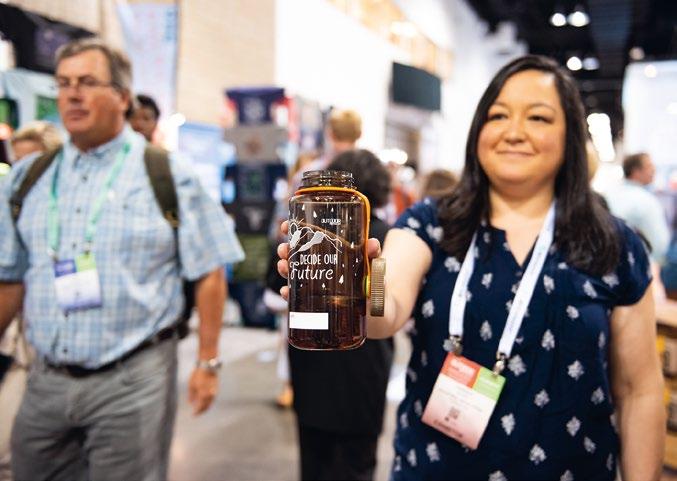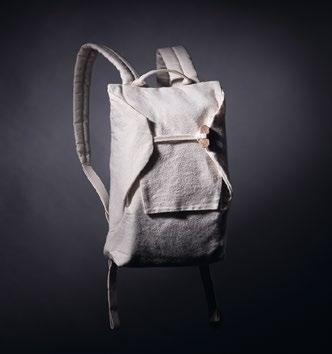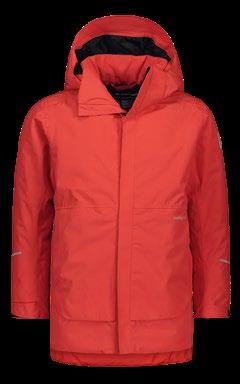
15 minute read
News
Prof. Johan Rockström, Director of the Potsdam Institute for Climate Impact.
Advertisement
Patagonia’s New Climate Goal PHOTO: i STOCK
PATAGONIA recently announced its plan to eliminate or mitigate all its carbon emissions by 2025. To achieve this goal, it will embark on a four-part process that is aimed to stabilize the company’s carbon footprint at zero, while the business continues to grow.
The first part involves acquiring robust data using a third-party validated system to measure the company’s impacts from raw resource extraction to material creation to delivery of products to customers.
With reliable data in hand, the second part involves reducing their impact. With the majority of emissions coming from producing the product’s materials, Patagonia plans increased use of recycled materials, extending product lifespans and a program that aims to calculate and reduce greenhouse gas emissions along Patagonia’s supply chain.
The third part involves a conversion to renewable energy. Already by the outset of 2020, Patagonia aims to have its global owned and operated locations 100 percent renewably powered. Within its supply chain, Patagonia is also supporting its suppliers to invest in renewable energy projects at their facilities.
The fourth and final part aims to capture the remaining carbon emissions via Regenerative Organic Agriculture and reforestation projects.
INTERNATIONAL SKI WAX BAN Citing concerns for negative environmental and health impacts, the International Ski Federation (FIS) has announced that it will ban all fluorinated ski waxes from all its sponsored ski events effective winter 2020/2021.
AUSTRALIA’S CHERNOBYL MOMENT? Australia’s climate policy – or lack of one – has often received criticism internationally. Will the ongoing wildfires change that? In Australian media, some are calling them a “Chernobyl moment” for the country and in a national survey in November, 57% stated they believe climate change is linked to bushfires.

REI’S 52 RESOLUTIONS FOR THOSE LOOKING TO make a difference in 2020, REI’s Opt to Act Plan has some suggestions. 52 of them, in fact, one for each week of the year. The first week of February, for example, participants are challenged to “Call your utilities company to ask about green energy options.” Some other highlights include: Week 3: Opt out of junk mail. Week 21: Celebrate Earth Day by contacting your local representative to advocate for environmental action. Week 23: Don’t wash your jeans all month. Week 33: Repair an item instead of purchasing a new one. Week 48: Attempt to create zero food waste this week.

Crowd-Funded Sustainable Shoe
IN A BID to “shake up the shoe industry,” the Swedish shoe producer Icebug initiated a Kickstarter campaign last December with the goal of financing what Icebug claims will be the most sustainable running shoe on the market. The shoe, Outrun, is 200% carbon offset, is manufactured in a factory equipped with solar modules, has an outsole that is PFC free and made of 15 percent recycled rubber, an upper in recycled polyester and 20 percent of the midsole is made of Bloomfoam, a biomaterial made from algae. By January 9th, Icebug achieved its goal of SEK 200.000 (USD 21,000).


Banned Substances 2.0
SINCE 2011, The Zero Discharge of Hazardous Chemicals (ZDHC) Roadmap to Zero initiative has been maintaining a comprehensive Manufacturing Restricted Substances List (MSRL) for the textile industry to achieve cleaner water, cleaner air, and safer production. This January marks the beginning of the transition period into the second revision of ZDHC’s MRSL, whereby signatories will have 12 months to align their production with the updated requirements. MOST SUSTAINABLE DESTINATION The Global Destination Sustainability Index (GDS-Index) is the leading sustainability benchmarking and improvement programme for meetings and events destinations around the world. Topping the list for the last four consecutive years is the city of Gothenburg, Sweden.

FORGET SOUL MATES – FIND AN ACTIVITY BUDDY
MANY MAY REMEMBER how easy it was to find playmates as kids. But adult life is different. Old friends lose touch, perhaps relocating to a new city. First bummed, the Canadian app developer Hafiz Mitha soon saw it for what it was – an opportunity. Partnering with Mountain Equipment Co-op (MEC) and the Vancouver-based accelerator Radius Slingshot, Mitha developed PlayCity, a platform that works like a dating app, allowing users to find “activity buddies” based on activity type, fitness level and availability. Thanks in part to support from MEC’s community grant program, Playcity has been able to spread across Canada.
LONDON’S MICROSMOG Textile microfibers have been found to be in abundance in the air we breathe. A recent report citing a sample from a nine-story building found 575-1,008 pieces of fibrous microplastic debris descends on every square meter of central London, every day. These particles can also remain airborne for weeks, and can be transported thousands of kilometers.
Does anyone else feel like we’re living in turbulent, confusing and crazy times? In this digital age, we have all the information, yet can’t agree in which direction we should be heading together. As much as in any other area, this challenge applies to CSR and sustainability. There is huge motivation and momentum building, but I fear that we are not making the most out of the opportunity.
Everyone seems to be charging off in different directions. What are the next steps our businesses need to take to remain relevant? Is it about carbon, or climate in general, and what about the social side? What scientific foundation do we base these steps on? And how can we measure them? To better move forward together, I think we need to first define a very fundamental starting point: our common ground. We must address this before we talk about details or specific measures. In our case, isn’t where we come from also part of our future – and the very best reason for why we do what we do? Our sector only exists because there are beautiful nature and active people who want to venture out into it. The outdoor industry, as we in the EOG see it, stands on three pillars: Doing business right; conserving and restoring nature; and encouraging people to get active outdoors. If we build all that we do on these three pillars, we can prepare our sector for the future, prospering with sustainably profitable businesses, while giving back more than we take from nature and people. Achieving this requires collective leadership, investment and sustained commitment. Thanks partly to the work of the EOG, the outdoor sector already has a very successful history of working together and is now starting to gather around the three pillars. Having defined our industry’s common ground, having it in writing as our mission and vision, that is the opposite of confusion. Now we have to make it happen and the journey has already begun. OUR COMMON GROUND
RENEWABLE ONLY Imagine a world where companies are powered entirely by renewable energy. RE100 is a leadership initiative that sets out to achieve just that – affirming that renewables are good for the environment and for business. Companies that commit to RE100 commit to energy transparency, with a goal of shifting to 100% renewables by a set year. there100.org
CLIF BAR IS IN The American energy bar brand has been doing this successfully for the last 10 years, having purchased green electricity certificates covering 100% of its operations. Clif Bar’s latest achievement includes the addition of a massive solar farm and pollinator habitat at its Idaho bakery. Other participating brands include VF Corp and Nike.
Are Green Fridays Here to Stay?

PERHAPS THE LONG QUEUE outside of the Naturkompaniet, Sweden’s largest specialty outdoor retailer, store in Malmö wouldn’t normally raise any eyebrows on a Black Friday. But those waiting weren’t braving the cold for rock-bottom prices on the latest gear – they were there for the pop-up secondhand store.
During the weeks prior, the Naturkompaniet shop in Malmö had collected around 500 products – everything from snowboards to thermo wear, shell jackets and old backpacks from the 70s. “It exceeded all expectations,” says store manager Björn Mattsson, who was responsible for the event.
Indeed, it didn’t take long for the shelves to empty, with nearly 70 percent being sold before noon. At the end of the event, just ten percent remained to be picked up by its owners or donated to a local charity.
In stark contrast to the usual Black Friday mayhem, Björn shared how he was moved by just how positive the atmosphere was throughout the event:
“Our customers are often satisfied, but this went beyond. I’ve never received so many positive comments – both in the shop and in social media,” shares Björn.
While the huge response was inspiring, it also gave him some food for thought regarding how much stuff is probably lying around unused at people’s homes:
“Good gear can have a long life, and the best from an environmental perspective is of course that whatever is already produced also gets used instead of us buying new all the time.”
Naturkompaniet is joined by an increasing number of outdoor retailers and brand stores that have decided to buck the mass-consumption mania of Black Friday, year after year, begging the question of whether Green Fridays have gone beyond a clever, yet well-intentioned, PR stunt to become a new, established tradition?
20
THIS YEAR, the Swiss environmental consultancy services provider and standard Bluesign celebrates 20 years of making the textiles industry’s supply chains cleaner and safer. PERCENT of a garment’s climate impact, 70 percent of its energy use and nearly 100 percent of the water and toxicity impacts occur during the production stage. Read more on page 34–36. 80
Driving Change in the Industry

The outdoor industry has years of leadership in sustainable practices, and many of those efforts are recognized at the Outdoor Retailer trade shows. The B2B events, for example, bring the outdoor community together to do business. They also provide a platform for the industry to share discoveries, hurdles, and wins on the path to reducing impact. Just as brands have been making strides in responsible product development, Outdoor Retailer has similarly worked with vendors and partners to drive change in event production. Recycling efforts, refillable bottle programs, and the reuse of materials are just a few examples of initiatives that have long been a part of the show. Farewell, single-use bottles... New for the show’s Summer Market in 2019, Outdoor Retailer was able to eliminate the sale of single-use bottles with support from the venue, the Colorado Convention Center in Denver, and concessionaire, Centerplate.
“Outdoor Retailer is a platform for the outdoor industry, and our show reflects the values of our community,” said Jennifer Pelkey, Senior Marketing Director, Outdoor Retailer.
“The eliminate-single-use-bottles campaign is something we’ve worked on together with brands like CamelBak, Klean Kanteen, Stanley, and Nalgene on for more than ten years, and this represents a milestone we’ve now been able to achieve in Denver.” Outdoor brands are continually leading the way towards a sustainable industry. Twice a year, Outdoor Retailer offers them a responsible platform for sharing.
...And carpets too Starting with the June 2019 show, Outdoor Retailer also eliminated aisle carpet. The show had been using carpet made from up to 50% post-industrial fibers which was returned to the manufacturer for reuse or recycling. Getting rid of it saved 1,200 gallons of diesel fuel from shipping, preventing 12 metric tons of carbon from entering the atmosphere. These efforts laid the groundwork for subsequent shows in the convention center to do the same, as well as events in other markets. And through initiating a sustainability audit at the summer show, Outdoor Retailer plans to apply those learnings to the show, as well as provide more sustainability solutions for those attending and exhibiting.
But, the bigger sustainability stories at the Outdoor Retailer shows are always evident in the brands and retailers. They’re finding innovative approaches to reduce impact in products and processes – from new fabrics to cleaner manufacturing. Many are working with the Outdoor Industry Association’s Sustainability Working Group to identify ways to improve. And, all are inspiring each other to make social and environmental stewardship a priority.
“Changes were achieved because individuals and brands are willing to look at their own impact,” Pelkey said.
“There’s a lot to be said for groundswell support and an environment where individuals and organizations accept wholesale changes to move initiatives forward. As we all plan ahead now, whether as brands or retailers, we all need to consider our own choices and the impact we want to have. Part of what Outdoor Retailer is doing, and will continue to do, is to make the choices our attendees have easier. The rest will be looking at ourselves and how we, as an event, can achieve not only a net zero impact, but a net positive impact.”
Outdoor Retailer’s Outdoor + Snow Show takes place January 29-31, 2020 at the Colorado Convention Center in downtown Denver, Colorado. Summer Market will be at the same venue from June 23-25, 2020. outdoorretailer.com TWO SHOWS IN 2020
A Backpack Made From Wood

Spinnova and Bergans have entered a collaboration with a clear goal: To develop a new and revolutionary way of sustainably manufacturing textiles. The very first prototype product is already in use. L ast year, the Finnish fiber producer and Norwegian outdoor brand announced they had entered a long-term product development collaboration, combining Finnish and Norwegian interests in sustainability, technology and outdoor life. The aim was to further develop a technology for cellulose-based textile fibers, without any harmful chemicals. And the hope was nothing less than finding solutions to revolutionize the textile industry.
Technologies based on cellulose textile fibers through chemical processes have existed for some time. What makes Spinnova’s solution so revolutionary is that all harmful chemicals are replaced by a mechanical process. The patented technology includes neither waste nor side streams, reducing the fiber and production method’s impact substantially. Spinnova’s raw material commitment is to only use FSC certified wood or material from waste streams.
Bergans of Norway is one of the first suppliers to develop a complete product made using the Spinnova fiber. After great efforts, the Norwegian brand presented the first product using the new technology already at the end of last year: a plain backpack using Scandinavian wood as raw material and made without harmful chemicals.
“The aim with this futuristic product is to get the Spinnova technology tested. Our hope is that the project could be a step towards a more sustainable textile consumption,” says Bergans CEO Jan Tore Jensen. A new way of producing The product is still a prototype and only available in a very limited quantity.
Even so, both partners emphasize the importance of launching the product for consumers to let them take part in its further development.
“We want to let consumers get to know our material by allowing them to physically test products. For that, we need innovative and risk-willing manufacturers. Bergans has shown a pragmatic and open attitude to trying new materials, even before they are commercially profitable,” says Janne Poranen, CEO of Spinnova.
A new way of owning But it’s not only about inventing new materials and products. The Norwegian developers are also eager to test new ways of consumption and circular business models. And the way the new backpack with the “wooden” fiber will be linked to the consumer market is unlike anything else.
Even if the pack will be tested among Scandinavian and German consumers, it’s not for sale in the traditional way. The idea is to give consumers the opportunity to buy in as co-owners in the fabric quantity.
“Currently, the fabric quantity is designed for backpacks. After a period of use, the consumer can return the backpack, have it recycled into new Spinnova material and reshaped into a new and different product,” suggests Johannes Flem, designer at Bergans Future Labs. And so, the cycle will continue.


The Jacket of Our Future
Since industrial-scale textile recycling is still in early stages of development, Reima realized a few years ago that circularity in kids’ clothing needs to start at the designer’s desk. Circularity is possible, but one needs to start thinking about the end of the product’s use life, before it even goes into production. That’s how Reima came up with its mid-season shell jacket Voyager and its winter version, Kulkija (Finnish for “one who travels”).
All layers of Kulkija, including the membrane, are made of 100% polyester. This makes it possible to recycle the whole jacket – apart from the unavoidable metal zipper lock and one piece of elastic in the powder skirt. Reima is committed to taking back every Kulkija jacket at its end-of-life, and delivering them to a partner waste management company for recycling back into fibers. However, Reima also believes that reuse is an important part of sustainability and clothing should be durable enough to be used by several kids. In Kulkija, Reima maintained its high standards of durability, water-repellency and windproofing, in addition to recyclability. Reima figured it would also be fun for kids and their parents to see where their jacket has been and where it ends up after them. Therefore, Reima encourages all families to register their Kulkija jacket’s unique code online, where they can follow the story of their jacket. Kulkija is the jacket of the future: Made from mono-material, built to last, easily recycled back to fibres that can get a new life in new products.
After hopefully many happy kids have had numerous adventures with them, families will be able to return their Kulkija jackets either at Reima retail stores, or through Reima’s clothing subscription service, Reima Kit. Reima will then deliver them to its Finnish waste management
partner. They will chop, shred and compress the jackets back into polyester fiber pellets that can then be used as raw material for e.g. furniture. HOW WILL KULKIJA BE RECYCLED?
ISPO Munich: Hall A2/114 OR Snow Show: 39038-UL reima.com









